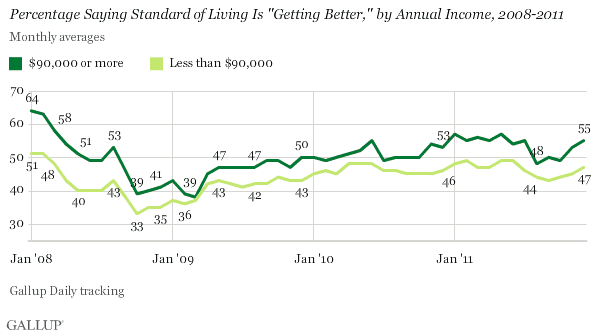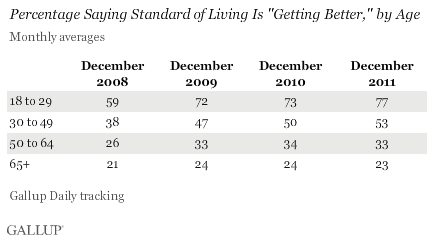PRINCETON, NJ -- Gallup's Standard of Living Index was at 31 in December, the highest since June and up slightly from the 30 of December 2010.

Americans' standard-of-living perceptions in December are much better than the 16 measured in December 2008 as the recession and financial crisis deepened. The current index level, however, remains below the 36 of January 2008 as the recession was just getting underway.
The Standard of Living Index is based on two questions asking Americans whether they are satisfied with their current standard of living and whether their standard of living is getting better or getting worse. Both dimensions have improved in recent months.
Standard-of-Living Optimism Across Income Groups Improves
Fifty-five percent of upper-income Americans (those earning $90,000 or more per year) and 47% of lower- and middle-income Americans (those earning less than $90,000) said their standard of living was getting better in December -- a return to the higher levels of mid-2011, but roughly the same as December of a year ago.

The percentage of Americans saying their standard of living is getting better declined as the recession deepened in 2008. In fact, as the financial crisis worsened, making the recession even more pronounced during late 2008 and early 2009, upper-income Americans' optimism about their standard of living declined to the point that it essentially matched that of their lower- and middle-income counterparts.
This situation was nearly repeated in August 2011 as the U.S. debt ceiling crisis took place. It was not until November that the gap between the two income groups returned to its normal larger size.
Standard-of-Living Optimism Higher and Increasing Among Younger Americans
Younger Americans are generally more optimistic than other age groups about their standard of living, with the percentage saying it is getting better typically higher than the percentage of older Americans who say the same. However, while younger Americans' optimism increased between December 2009 and December 2011, optimism among Americans aged 50 and older did not.

Americans in the East grew slightly more optimistic about their future standard of living in December 2011 compared with December 2010, restoring parity between the East and other regions of the country on this measure.

Americans' Personal Balance Sheets Still Need Healing
Regardless of income, age, or region, Americans were more optimistic about their future standard of living in December 2011 than they were in December 2008 as the financial crisis was underway. However, Americans' optimism about their standard of living has improved only slightly since December 2009.
Lower- and middle-income Americans' optimism about their standard of living has not increased as much as their upper-income counterparts' has since early 2009. This may be partly a result of the unprecedented period of high unemployment during the past several years, which has adversely and disproportionately affected lower- and middle-income Americans. It is also consistent with the reduced spending of recent years, with particularly sharp drops among these two groups. Unemployment affects the financial well-being of upper-income Americans less, while Wall Street influences it more -- and the markets have improved significantly since March 2009.
Low interest rates and a lack of low-risk investment returns have likely had a negative impact on older Americans' financial well-being. These Americans probably have also seen their home values decline, along with their retirement assets. Younger Americans are not only generally more optimistic than their older counterparts, but also tend to have fewer assets and thus are less likely to have experienced some of the negative effects of the recession on their financial well-being.
Whether the lack of improvement since 2009 in older Americans' and in middle- and lower-income Americans' perceptions of their standard of living will have a political impact is unclear. But like consumer confidence, a significant improvement in Americans' perceived standard of living could be positive for the president's re-election efforts.
Gallup.com reports results from these indexes in daily, weekly, and monthly averages and in Gallup.com stories. Complete trend data are always available to view and export in the following charts:
Daily: Employment, Economic Confidence and Job Creation, Consumer Spending
Weekly: Employment, Economic Confidence, Job Creation, Consumer Spending
Read more about Gallup's economic measures.
View our economic release schedule.
Survey Methods
Results are based on telephone interviews conducted as part of Gallup Daily tracking to Dec. 1-29, 2011, with a random sample of 12,924 adults, aged 18 and older, living in all 50 U.S. states and the District of Columbia, selected using random-digit-dial sampling.
For results based on the total sample of national adults, one can say with 95% confidence that the maximum margin of sampling error is ±1 percentage point.
Interviews are conducted with respondents on landline telephones and cellular phones, with interviews conducted in Spanish for respondents who are primarily Spanish-speaking. Each sample includes a minimum quota of 400 cell phone respondents and 600 landline respondents per 1,000 national adults, with additional minimum quotas among landline respondents by region. Landline telephone numbers are chosen at random among listed telephone numbers. Cell phone numbers are selected using random-digit-dial methods. Landline respondents are chosen at random within each household on the basis of which member had the most recent birthday.
Samples are weighted by gender, age, race, Hispanic ethnicity, education, region, adults in the household, and phone status (cell phone only/landline only/both, cell phone mostly, and having an unlisted landline number). Demographic weighting targets are based on the March 2010 Current Population Survey figures for the aged 18 and older non-institutionalized population living in U.S. telephone households. All reported margins of sampling error include the computed design effects for weighting and sample design.
In addition to sampling error, question wording and practical difficulties in conducting surveys can introduce error or bias into the findings of public opinion polls.
For more details on Gallup's polling methodology, visit www.gallup.com.
